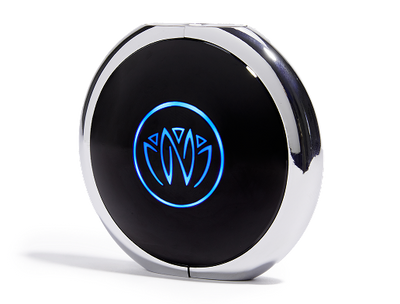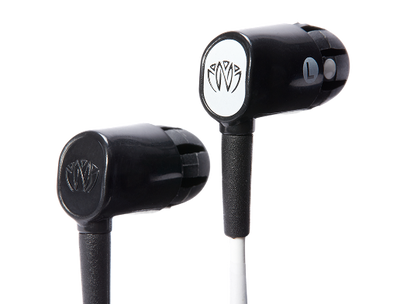If you feel like your nervous system is always in overdrive, you could be experiencing symptoms like anxiety, stress, irritability, and even depression. Luckily, there are many things you can do to help calm your nervous system down – including stimulating the vagus nerve.
Today, we'll tell you more about the nervous system and how vagus nerve stimulation can help get you from "fight or flight" to "rest and digest."
Let's start with some of the basics of the nervous system.
Understanding the Nervous System
The nervous system is responsible for coordinating both voluntary and involuntary actions within the body. It comprises two main divisions: the central nervous system (CNS) and the peripheral nervous system (PNS).
The CNS includes the brain and spinal cord, while the PNS consists of the nerves that connect the CNS to the rest of the body. The PNS is further divided into two parts: The somatic nervous system and the autonomic nervous system.
The somatic nervous system controls all of the voluntary muscles in your body – think lifting your arm or leg. On the other hand, the autonomic nervous system controls all of the involuntary muscles – like those in your digestive tract or heart.
The autonomic nervous system is further divided into two parts: The sympathetic nervous system and the parasympathetic nervous system.
The sympathetic nervous system is responsible for the "fight or flight" response, while the parasympathetic nervous system is responsible for the "rest and digest" response.
In other words, when you're in a stressful situation, it's the sympathetic nervous system kicks in to help you deal with that stressor. Then, once the stressor has passed, it's the job of the parasympathetic nervous system to help your body return to a state of rest.
Unfortunately, in today's world, we're often in a state of chronic stress – which means our sympathetic nervous systems are constantly activated. This can lead to a host of problems, including anxiety, insomnia, and even depression.
What Causes Your Nervous System to Go Into Overdrive?
Several things can run your nervous system into overdrive, including:
- Chronic stress: As we mentioned, chronic stress is one of the most common causes of an overactive nervous system. When constantly stressed, your body never has a chance to fully recover, which can lead to a host of health problems.
- Poor diet: A diet high in processed foods and low in nutrient-rich whole foods can also contribute to an overactive nervous system. Processed foods tend to be high in sugar, which can cause spikes in blood sugar levels that can lead to anxiety and other problems.
- Lack of sleep: Not getting enough rest is another common trigger for an overactive nervous system. When you're tired, your body is under more stress, which can lead to many issues.
- Sedentary lifestyle: A sedentary lifestyle can also lead to an overactive nervous system. When you don't get enough physical activity, your body becomes less efficient at managing stress, which can make it more difficult to cope with everyday challenges.
- Life events: Major life events, such as a death in the family or a divorce, can also run your nervous system into overdrive.
If you're experiencing symptoms of an overactive nervous system, it's important to find a way to calm down. Otherwise, you could be at serious risk for critical health problems.
Fortunately, there are several things you can do to help calm your nervous system down.
That's where vagus nerve stimulation (VNS) comes in.
What is the Vagus Nerve?
The vagus nerve is the longest cranial nerve in your body. It runs from the brainstem all the way down to the pelvis, influencing nearly every system in your body. Because it's so long, it's sometimes referred to as the "wandering nerve."
This nerve plays a vital role in the autonomic nervous system – specifically, the parasympathetic nervous system. In other words, it helps regulate your body's "rest and digest" response.
The vagus nerve also plays a role in several other essential functions, including:
- Heart rate
- Blood pressure
- Digestion
- Inflammation
- Mood
For this article, we're going to focus on the vagus nerve's role in calming the nervous system.
How Does Vagus Nerve Stimulation Work?
Vagus nerve stimulation (or VNS) is a therapy that involves sending electrical impulses to the vagus nerve. This therapy has been used to treat a variety of conditions, including epilepsy, depression, and migraines.
There are different ways to do this. To name a few, surgical implantation of vagus nerve stimulation devices or less invasive methods like the Xen by Neuvana vagus nerve stimulation device. For the more invasive methods, the goal is often to treat health conditions, including epilepsy. However, improving your overall wellness tends to be the goal when it comes to the more accessible, less invasive methods.
For example, many people who use vagus nerve stimulating headphones report a brighter mood, better sleep, faster recovery, and, yes—less stress! This is due to the powerful effect vagus nerve stimulation can have on calming your nervous system, so let's move on to that next.
How Does Vagus Nerve Stimulation Calm Your Nervous System?
We've covered the basics of the nervous system and vagus nerve stimulation. Now, let's take a closer look at how VNS can help calm your nervous system.
As we mentioned earlier, the autonomic nervous system is responsible for controlling all of the involuntary muscles in your body. This includes the muscles in your heart, lungs, and digestive tract, which can be affected by stressful situations.
For example, think of the butterflies in your stomach or the racing heart you might get when you're nervous. These are just two of many examples of how stress affects us. But vagus nerve stimulation can better control our response to stress.
Vagus nerve stimulation does this by activating the parasympathetic nervous system. As we mentioned earlier, this is the "rest and digest" response. When your body is in a state of rest, it's better able to heal and repair itself. This is one of the reasons why vagus nerve stimulation can be so beneficial for overall health and well-being.
Not only can vagus nerve stimulation help you feel calmer in stressful situations, but it can also help reduce inflammation, improve digestion, and even boost your mood! So if you're looking for a natural way to improve your overall health, vagus nerve stimulation is definitely worth considering.
How Do You Stimulate The Vagus Nerve To Relax?
If you want to try vagus nerve stimulation at home, there are a few different ways to do it. One of the simplest, most accessible, and effective methods is to use vagus nerve stimulation headphones. These work by sending gentle electrical impulses to the vagus nerve through the ear, which can help activate the calming "rest and digest" response.
Calming down by stimulating the vagus nerve
Vagus nerve stimulating headphones are a powerful option, but they aren't the only option at hand when you're calming your nervous system with VNS.
7 Ways to Stimulate the Vagus Nerve
Here are seven other methods for VNS you can do from home.
Music
When you listen to music, it creates a vibration in your eardrums that can stimulate the vagus nerve at the same time. Then, the calming effects of the music can further help reduce stress and anxiety.
Cold Exposure
You can also stimulate your vagus nerve by exposing yourself to cold temperatures. This could be in the form of cold showers, ice baths, or even just a face mask filled with ice cubes. The cool temperature sends a signal to your body that activates the vagus nerve, which then helps when it comes to calming your nervous system.
Massage
Giving yourself a massage is another effective way to stimulate the vagus nerve. Here's a handy video explaining where and how to target the vagus nerve with a massage.
Yoga
Certain yoga poses, such as sarvangasana (shoulder stand) and halasana (plow pose), can help stimulate the vagus nerve. This is largely due to the inverted position of the poses, which helps increase blood flow to the head and neck area.
Breathwork
Deep breathing exercises can also help stimulate the vagus nerve. One popular breathwork exercise is alternate nostril breathing.
To do this, simply hold your right thumb over your right nostril and take a deep breath in through your left nostril. Next, shut your left nostril with your ring finger and release your right thumb. Finally, breathe out through your right nostril. Repeat for a few minutes.
Meditation and humming
For centuries, meditation practices have been used to calm the mind and body. And, it turns out, it can also help stimulate the vagus nerve. In fact, any type of mindfulness practice can be beneficial for vagus nerve stimulation.
Humming is another great option for stimulating the vagus nerve. This is because the humming vibration can help massage the vagus nerve. Not to mention, it's a great way to help you relax and de-stress!
Exercise
Is there anything exercise CAN'T do?! Sure, it's great for your physical health, but it can also help stimulate the vagus nerve. This is because exercise helps increase blood flow to the head and neck area, where the vagus nerve is located.
So, if you want a way to calm your nervous system naturally, vagus nerve stimulation is worth considering. There are various ways to do it so that you can find the best method. And, the best part is, you can do it all from the comfort of your own home!
But less stress from calming your nervous system isn't the only benefit you can reap from VNS.
Benefits Of Vagus Nerve Stimulation To Calm The Nervous System
Here are seven other ways VNS can improve your life by calming your nervous system.
Depression
Robust evidence suggests that vagus nerve stimulation (VNS) is an effective treatment for depression, with one study showing that it can be just as effective as traditional antidepressant medications.
Regulate emotions
VNS is also helpful when it comes to regulating your emotions. This is because the vagus nerve is responsible for sending calming signals to the brain and helping maintain an emotional balance. So, with VNS, you can help regulate your emotions and keep them in check.
Reduce blood pressure
If your blood pressure isn't where you want it, it might be worth exploring VNS as a possible treatment option. This is because VNS can help to lower blood pressure by calming the nervous system and decreasing stress levels.
Ease digestive issues
VNS can also be helpful for those who suffer from digestive issues because the vagus nerve plays a role in regulating digestion. With VNS, you might be able to help ease digestive issues like constipation, diarrhea, and bloating.
Lower your heart rate
VNS has also been shown to be useful in lowering heart rate.
Consider these interesting findings from a 2006 study:
"VNS can be used effectively and rapidly to decrease heart rate, in acute settings, when connected to an external pacing system. Future devices that are fully implantable may be used for nonpharmacological treatment of illnesses in which tachycardia results in deterioration of cardiac function."
Reduce inflammation
Surprisingly, inflammation and VNS are also connected. Research shows that VNS can help to manage diseases associated with excessive inflammation.
Take a look at what this research from 2019 finds:
"Neural reflexes regulate inflammation and electrical activation of the vagus nerve reduces inflammation in models of inflammatory disease. These discoveries have generated an increasing interest in targeted neurostimulation as treatment for chronic inflammatory diseases. Data from the first clinical trials that use vagus nerve stimulation (VNS) in treatment of rheumatoid arthritis and Crohn's disease suggest that there is a therapeutic potential of electrical VNS in diseases characterized by excessive inflammation. "
Treat migraines and cluster headaches
If you suffer from migraines, VNS could be a helpful treatment option. For many people, VNS can help block pain signals from reaching the brain, which can help reduce migraines' intensity.
Cluster headaches are another type of headache VNS is often helpful for. A cluster headache is a severe, one-sided headache that typically lasts for 15 minutes to 3 hours. They can occur daily or weekly in clusters, hence the name.
While cluster headaches are less common than migraines, they can be just as debilitating. And, like migraines, VNS has been shown to be an effective treatment for cluster headaches. For example, one study found that VNS could significantly reduce the frequency and severity of cluster headaches in those who used it.
If you suffer from migraines or cluster headaches and seek a drug-free treatment option, VNS could be worth exploring.
Other Tips for Calming Your Nervous System
Along with VNS, other practices are worth considering if you want to calm your nervous system and lower your stress levels. Here are seven of them.
Practice deep breathing
One simplest and most effective way to calm your nervous system is to practice deep breathing. Deep breathing helps activate your vagus nerve, which in turn helps to calm the nervous system.
Get regular exercise
Regular exercise is another great way to calm your nervous system. Exercise helps to reduce stress and anxiety, and it also helps to improve sleep quality. All of these factors can help with calming your nervous system.
Avoid caffeine
Caffeine is a stimulant, so it's not surprising that it can worsen anxiety and stress. If you're struggling with calming your nervous system, it might be worth cutting back on caffeine or eliminating it from your diet altogether.
Practice yoga or meditation
Yoga and meditation are both great for calming the mind and the nervous system. Both practices help to reduce stress and promote relaxation. If you're new to yoga or meditation, plenty of free online resources are available to help you get started.
Get adequate sleep
Sleep is crucial for your overall health, and it's also important for calming the nervous system. When you're well-rested, you're better able to manage stress and anxiety. So, prioritize getting 7-8 hours of shut-eye each night, and avoid using electronic devices in the hours leading up to bedtime.
Connect with others
Connection is an integral part of calming the nervous system. When we feel isolated and alone, it can make stress and anxiety worse. Connecting with friends, family, or a supportive community can help to reduce stress and promote calming of the nervous system.
Spend time in nature
This is another excellent way to calm your nervous system. Nature has a calming effect on the mind and can help reduce stress and anxiety. So aim to spend some quality time outdoors each day, and consider adding plants to your home or office for an extra dose of calming nature.
Vagus nerve stimulation (VNS) is a promising option for those looking to calm their nervous system. VNS has also been shown to be helpful for conditions like migraines, cluster headaches, and inflammatory diseases. Along with the Xen by Neuvana vagus nerve stimulating headphones, other practices can help to calm the nervous system, such as deep breathing, exercise, yoga, meditation, and spending time in nature.
If you're looking for ways to reduce stress and promote relaxation, consider incorporating some of these calming practices into your daily routine.





